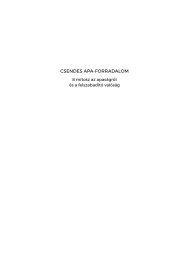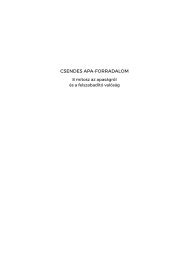Csaba Lentner - East of Europe, west of Asia
Create successful ePaper yourself
Turn your PDF publications into a flip-book with our unique Google optimized e-Paper software.
2.1 The Austro-Hungarian Compromise of 1867 and its outline history | 25
suth submitted a detailed report to the Parliament entitled “On the country’s
finances and budgetary plan for the second half of 1848 and for 1849”. The
proposal included the budget for the period between 11 April and 30 June
1848, separately for the second half of 1848, and a more generous budgetary
plan for the year 1849. The proposals were presented on a balance sheet
basis, together with the amount of deficit and method of financing. In addition,
budget appropriations, major items and relationships were presented
by ministries with separate calculations and with detailed explanations. Kossuth
has presented a bill on the levying of taxes, such as “about the taxation
in the current half a year of formerly tax-free classes of the country, the extraordinary
income tax, the extraordinary brandy tax”. In order to cover the
country’s public needs in the current half a year, a decision was also taken
on credit (up to 16,000,000 pfrt), ad hoc taxes and “direct” taxes. 79 The establishment
of the financial management of the independent Hungarian state,
making money and even the “measures taken to eliminate and overcome the
difficulties of currency exchange”, 80 “the negotiations with the management
of the Hungarian Commercial Bank” 81 on the issue of banknotes – covered
by the sacrifice of the nation – the bridging of the deficit by credit 82 reveals
a wide range of tasks.
In addition to the creation and approval of a separate budget another fundamental
issue of financial autonomy was the independent banknote issuance.
To this end, Kossuth started negotiations with the Hungarian Commercial
Bank of Pest. At first, he attempted to create the collateral security of the
new banknotes for precious metal ores by subscribing a loan. On May 23,
1848, Kossuth called on the nation to subscribe for interest-bearing treasury
vouchers with a denomination of 50 and 100 forints, with a maturity
of 3, 6, 9, and 12 months, and promised a 5 percent interest. The vouchers,
getting into the circulation of money, were later used also as banknotes, but
the results expected at the time of issuance were not achieved: returns have
reached only one third of the projected amount. 83
The banknote issuance agreement with the Hungarian Commercial Bank
of Pest was concluded on 17 th June 1848. Under the contract, the Ministry of
Finance would have deposited 5 million forints in gold and silver as collateral
security, and in return the bank would have issued banknotes in a value
of 12 and a half million forints. The Ministry of Finance was able to raise
only a part of the collaterals – roughly it was equivalent to 1.8 million forints
– thus the issuance of banknotes was also proportional. 84 The conclusion
of the contract was of even more overriding importance, as the Hungarian
Commercial Bank of Pest has this way been transformed into a bank for
issuing banknotes thus creating an independent Hungarian central bank.
The forint was also used in the medieval Kingdom of Hungary, it was successful,
and later became a generally known currency of Austria-Hungary.
The name of the new, independent currency is therefore linked to historical
precedents, which sought to strengthen confidence in new money, because





